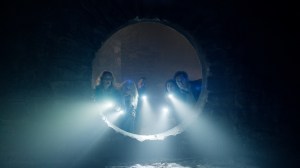
The world of comics is dominated by superheroes, but they almost all exist in two shared universes. It’s almost impossible to walk into a shop without seeing massive signs labeling the Marvel and DC sections, asking which universe is your favorite. The superhero genre has far more potential and options than this dichotomous relationship offers though. While there’s nothing wrong with the comics and universes offered by the “Big Two”, two options don’t make a market. That is what makes it all the more exciting when a new expansive superhero universe emerges in the comics market. In the last couple of years that is exactly what has happened as Black Hammer premiered and has quickly risen to stand alongside other proud competitors like Astro City and Valiant Comics.
Videos by ComicBook.com
Black Hammer debuted at Dark Horse Comics in 2016, co-created by Jeff Lemire and Dean Ormston, and has been met with critical and commercial success. The series follows a group of superheroes who were stranded in a small town seemingly set outside of time and space as they know it. There they have taken on new personalities and slowly given up hope of ever returning home. That premise belies a rich superhero universe filled with history and characters, as well as the long story behind its creation. As we continue to seek out new ideas for superhero comics, Black Hammer and its creators reveal what it takes to make a new superhero universe work.

The Birth of Black Hammer
Lemire originally conceived the idea of Black Hammer in 2007, and it was quickly accepted at Dark Horse Comics. While changes were made between then and its eventual premiere almost a decade later, the core concept of the series remained intact. The concept of stranded heroes was present, but, more importantly, so was the commentary on the superhero genre. Each of the heroes present in Black Hammer and those that have been revealed outside of the small town of Rockwood all draw parallels and connections to the almost century-long history of the genre. It has always been a comic about superheroes more than a superhero comic.
The initial delays to the series were caused by Lemire’s rapidly burgeoning career. First, commitments to existing Vertigo series prevented him from drawing the comic. Then, an exclusive contract with DC Comics that ran through 2014 stopped its development. After that contract ended, Lemire was so busy with other projects that he was no longer able to draw Black Hammer himself. It was at this point that he reached out to artist Dean Ormston, another auteur comics artist who excels at depicting human fragility and pathos, to partner on the series. A final major delay arrived in the form of a cerebral hemorrhage that paralyzed the right side of Ormston’s body in 2015. After significant physical therapy, Ormston recovered his ability to draw, and Black Hammer was finally released on July 2016.

Building From Square One
Given its long history from conception to publication, it’s clear that Black Hammer wasn’t going anywhere. Something about the idea made it worth the wait and Lemire never stopped working on it, claiming to have written 20 issues shortly after the first issue was released. The most important element of Black Hammer #1 isn’t the superhero universe that surrounds it or the epic stories to come, it’s the great concept introduced in that first issue.
The first issue of Black Hammer is all about introducing its cast of characters and their dynamics. Each of the 6 surviving superheroes in Rockwood are revealed as people before much about their history, powers, or villains are revealed. It’s more important to understand Abraham Slam’s nostalgic perspective and devotion to his team and residents of Rockwood than what his costume looked like before his exile. That applies to all of the superheroes who are the focus of Black Hammer. They once belonged to a much larger world filled with many threats and other heroes, but the series removes them from that and focuses on a story worth telling.
When you look back at other important debut issues like Detective Comics #27 (Batman), Action Comics #1 (Superman), or Amazing Fantasy #15 (Spider-Man), none of them deliver a complete universe of superheroes. They each provide a central hero and concept that was allowed to grow into something much larger. The premise of Black Hammer is both focused and innovative enough to provide a starting point for bigger things. Lemire, Ormston, and their other collaborators can grow both the original story and develop the broader history of the universe. That’s only possible because of the strong foundation built in the original series.

A Brighter Future
After less than two years it has become abundantly clear that the story in Rockwood is far from the only one to be told in the universe of Black Hammer. It remains the central story, relaunched this week as Black Hammer: Age of Doom, but there have already been 2 spinoffs with at least 1 more planned. Sherlock Frankenstein and Doctor Star have examined the lives of other villains and heroes left behind on Earth when Black Hammer and the rest disappeared. The Quantum Age, another series planned for this fall, will jump 1,000 years into the future and reveal superheroes inspired by the originals.
Each of these spinoff series reveal a key element in how Lemire and Ormston have designed their ever-expanding superhero universe. Sherlock Frankenstein examines the mad genius trope of superhero comics with a lead that plays very similarly to Captain Marvel’s nemesis Doctor Sivana. Doctor Star is a riff on the Starman series created by James Robinson and Tony Harris, even going so far as to name its hero Jimmy and provide him with an appearance loosely based on the writer. Now The Quantum Age will riff on the Legion of Super-Heroes. The comics of Black Hammer may lack decades of history, but they are utilizing the shorthand and references crafted by other publishers. Allusions and similarities to classic properties allow these comics to quickly assemble characters and histories in a much shorter period of time.
Much like Astro City, Lemire and Ormston’s creation has been able to leverage the dominance of other superhero comics in order to quickly build their own. They aren’t reconstructing DC Comics or any other sort of story either. From the very first issue of Black Hammer its unique tone and approach to the genre are clear. There simply are no comics like this at any large superhero publisher. That’s what makes its success so exciting, including the multiple new series and Eisner win for Best New Series. Black Hammer took the unique take of one artist on superhero stories and has built something much larger from that foundation. The end result hasn’t even arrived yet as more and more comics are promised, but the future certainly looks promising.








